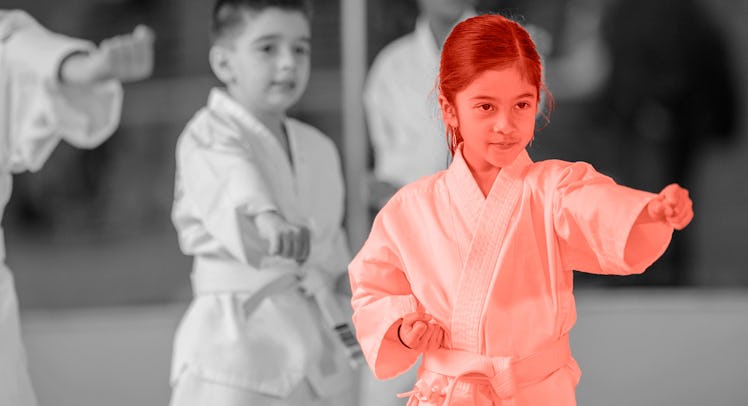How to Teach Kids Grade School Self-Defense
Many dads want to teach kids to defend themselves by decking a bully in the face, but sometimes well-crafted trash talk works better.

The prevalence of bullying in schools has some parents turning to self-defense classes for kids. Other parents might think self-defense classes sound like an extreme reaction to bullying hype trotted out by breathless local news readers. But both types of parents have it a little wrong. Teaching a child to take a swing at a mean kid gives them a dubious life skill, but may also not be the best approach. The thing about teaching little kids self-defense is that it pays to take a more practical approach. And that probably means trash talk.
“What we say in the industry is that 99 percent of all fights are 100 percent avoidable,” explains martial arts instructor Jason Zakrajsek, a Gracie Jiu-Jitsu black belt and owner of Kuk Sul Do Academy in Chagrin Falls. “Unless someone is absolutely physically attacking you, most everything can be resolved by verbal assertion, verbal de-escalation, or simply walking away.”
Zakrajsek is adamant that verbal assertion or de-escalation is one of the pillars of self-defense that is often skipped by well-meaning parents and anti-bullying advocates. He suggests some of this is likely due to the reticence some parents have in teaching their children to talk tough and be verbally assertive, fearing it’s impolite or rude. But in the “bully-proofing” program that Zakrajsek commonly teaches in schools, talking is one of three Ts to address a bully along with “telling” and “tackling.”
“At the end of the day, your ability to verbally assert yourself, or talk shit, without giving the bully the emotional result they want is key,” Zakrajsek says. “They have to learn that skill.”
It’s only when talking fails, explains Zakrajsek, that things should ever get physical. “You have a right to defend yourself when you’re being physically harmed,” he says. But that doesn’t mean taking defensive swings at a bullies nose. Because when kids start swinging, it’s anybody’s game. Plus, for outside observers, there’s no way to tell which kid is the aggressor. This is a particularly important note in schools that have a zero-tolerance policy when it comes to fisticuffs.
“I don’t teach anybody to sock anyone in the face,” Zakrajsek cautions. “I believe it’s a litigious society and that’s just bad news.”
Instead, he recommends that children “tackle” their aggressors. So rather than throwing a punch, kids will do better to get close, wrapping their arms around their attacker more akin to a wrestling hold or Jiu-Jitsu grappling. Once a kid is super close to an aggressor, they have much fewer options. “If you get into anything, just clinch with them so you get so close to them that it’s difficult to hurt you,” Zakrajsek says. This ultimately protects both kids, which has to be the goal here.
How To Teach Kids Self-Defense In Grade School
- Start by teaching a kid to be verbally assertive or verbally de-escalate a situation by standing up for themselves and not giving the bully the emotional reaction they’re looking for.
- Use role-play to put light stressors on a child that will help them practice how to react to a bully or aggressor.
- Don’t teach a child to swing. Instead teach them to keep a buffer zone, or tackle aggressor who has become physical to decrease their available options for attack
- Enroll the child in a good bully-proofing or martial arts program.
With specific training, children can learn to put a bully in submission holds. But receiving that training requires an investment of time and money.
Zakrajsek notes that parents who are unable or unwilling to put their child into a martial arts or bully-proofing training should at least make sure to role-play bullying situations with children so that they feel prepared. Simulation is, after all, at the heart of all martial arts training. Kids can’t be expected to react in a way that makes sense if they have never had practice. Importantly, those role-plays should include verbal de-escalation — a perfect time to teach a kid the finer points of trash talk.
“If it’s important to the parent, set aside some time,” Zakrajsek says. “Give the kid a little bit of pressure. You can get good results from that.”
This article was originally published on